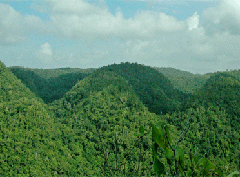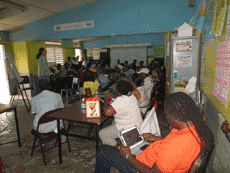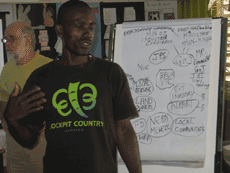 |
CATADUPA CONSERVATION ACTION PLAN |
 |
 |
 |
 |
 |
Catadupa Stakeholders Workshop:
Identifying
Stakeholders, Motivations, and Strategies
for our Conservation
Action Plan
Venue: Elderslie Primary and Junior High School
Date: 18th February 2015
Facilitator: Mike Schwartz (Windsor Research Centre)
Participants: 52 persons from 15
communities
Funded by:
|
|
|
Goal:
To identify the major stakeholders who are engaged in activities which threaten the health of and ecosystem services provided by the Catadupa ecoystem. By understanding the relative contributions of these stakeholders and the motivations which govern their decisions, effective strategies can be developed to eliminate or reduce significant threats.
Background:
Catadupa is the name we use for western Cockpit Country. It is a Key Biodiversity Area (KBA) with many special plants and animals, some of which are found only in Catadupa and nowhere else in the World. “KBA” is a globally-recognised designation, recognised both by conservation-oriented entities such as the International Union for the Conservation of Nature (IUCN) and by financial-development agencies such as the World Bank and the Inter-America Development Bank.
In previous workshops attended by community members and representatives from government agencies (including National Environment and Planning Agency [NEPA] and Forestry Department [FD]), stakeholders identified six Conservation Targets (Table 1) which, if protected, would ensure the health of the Catadupa ecosystem and the maintenance of key services, including provisioning of clean water, biological diversity, and heritage (culture and current community values). Stakeholders also identified the major threats to the Conservation Targets and evaluated the scope, magnitude, and irreversibility of each threat to each target. This allowed us to sum-up the threats and identify the most significant threats (Table 2).
|
Bauxite mining is the highest-ranked threat to the Catadupa KBA. Its threat status is VERY HIGH |
TABLE 1. Catadupa Conservation Targets
|
TARGET |
REASON TO INCLUDE |
|
1. Wet Limestone Forest |
Umbrella for all forest-dependent plants & animals |
|
2. Cave Communities (non-aquatic) |
Unique cave-dwelling species; can be harmed by human activities inside a cave |
|
3. Karst Freshwater Ecosystems |
Vulnerable to pollution |
|
4. Amphibians |
Not only a quality indicator of forest health (e.g., the “canary in the coal mine” for forests) but also potentially threatened by alien Chytrid fungus |
|
5. Giant Swallowtail Butterfly |
Endangered endemic butterfly; range is entirely restricted to Cockpit Country and Blue Mtns. |
|
6. Plain (aka Blue) Pigeon |
Illegal hunting may threaten the population |
TABLE 2. The highest-ranked threats to the Catadupa KBA

Elderslie Workshop:
1.
Key threats, stakeholders & motivations
Who are the stakeholders associated with
each threat and what motivates them?
A. Bauxite Mining
Workshop participants identified six categories of stakeholders: (1) elected officials; (2) civil servants / public sector; (3) public & private vested commercial interests; (4) commercial mining operators; (5) non-government (NGO) and community-based (CBO) organisations; and (6) members of the public. Each category has members which support and derive benefits from bauxite mining and has members which oppose mining because of the costs imposed by mining.
|
STAKEHOLDER |
MOTIVATION |
|||
|
1. Elected officials |
||||
|
Ministers |
Demonstrate competence to the electorate; prestige associated with delivering on election promises (i.e., improve chances for re-election); desire for economic growth and development; fear of negative media attention (esp. international media) |
|||
|
|
Minister of Science, Technology, Energy & Mining (STEM) |
Promote investment in the mining industry |
||
|
|
Minister of Industry, Investment & Commerce (IIC) |
Promote investment opportunities both locally and overseas |
||
|
|
Minister of Labour & Social Security (LSS) |
Maintain or improve numbers in the labour market |
||
|
|
Minister of Water, Land, Environment & Climate Change (WLECC) |
Protect and use sustainably Jamaica’s natural resources |
||
|
|
Minister of Finance & Planning |
Revenue; balance the budget deficit |
||
|
|
Minister of Tourism & Entertainment |
Promote high quality products and experiences |
||
|
Cabinet |
Satisfy IMF, re-election of Party. |
|||
|
Members of Parliament |
Same as Ministers |
|||
|
Parish Councillors |
Same as Ministers; desire for economic growth and development particularly in local communities |
|||
|
|
|
|||
|
2. Civil servants |
|
|||
|
Agencies (Ministries) |
Guided by enabling Acts and other relevant legislation; adhere to Mission Statements |
|||
|
|
Mines and Geology Division (STEM) |
Identifying Jamaica’s non-renewable natural resources for potential exploitation |
||
|
|
National Environment & Planning Agency (WLECC) |
Protecting natural resources; attempt to plan for best land and resource utilization |
||
|
|
Forestry Department (WLECC) |
Protecting forests |
||
|
|
Water Resources Authority (WLECC) |
Protecting aquifers and above-ground river systems (watersheds) |
||
|
|
Jamaica Tourist Board (JTB) |
Provide / promote high quality products and experiences |
||
|
|
|
|||
|
3. Public & private vested interests |
|
|||
|
Jamaica Bauxite Institute (JBI) |
Mission Statement; prestige on the global stage |
|||
|
Jamaica Public Service Co., Ltd (JPS) |
Bauxite companies feeding-into the national grid; GoJ’s acceptance of “dirty” and cheaper energy production (e.g. coal, Bunker-C oil) |
|||
|
National Water Commission |
Maintain source of clean water that is used by western Jamaica |
|||
|
University of the West Indies (UWI) |
Scientific curiosity; personal satisfaction within chosen profession; $$ (consulting) |
|||
|
Professional geologists & engineers |
$$; personal satisfaction within chosen profession |
|||
|
International Monetary Fund (IMF) |
Servicing of Jamaica’s debt |
|||
|
|
|
|||
|
4. Commercial mining sector |
|
|||
|
ALPART (GoJ) |
$$: meet demand for aluminum (esp. overseas markets); |
|||
|
International mining companies |
$$ for employees, directors & shareholders; prestige within the industry; motivation to work in any country will be driven by cost-benefit analysis: currently, companies are not bearing the full environmental and social costs in Jamaica -- they are facilitated in this aspect by GoJ, which doesn’t want to drive away the industry because they have become dependent on having a “cash cow” short-term revenue tax |
|||
|
Private company shareholders |
Good returns on investment |
|||
|
Private contractors |
$$ |
|||
|
|
|
|||
|
5. NGOs and CBOs |
|
|||
|
Windsor Research Centre |
Mission Statement; personal and professional desire to do the morally and ethically right thing |
|||
|
Jamaica Environment Trust |
Mission Statement |
|||
|
Benevolent Societies, etc. (NOTE: all communities need to list their CBO and other community-based assets as one key activity in our Catadapa Conservation Plan) |
Desire to support local community and retain or improve the quality of life for community members |
|||
|
|
|
|||
|
6. Members of the Public |
|
|||
|
Local land owners |
Sell land for $$ or, more likely, be compensated for lost access to assets during mining activities |
|||
|
Local community members (pro-mining) |
Jobs… but workshop participants noted that locals get very little direct employment and not the high-wage, high-skilled positions; instead they can “set up a shop and sell a juice to the factory employees” |
|||
|
Local community members (anti-mining) |
Don’t want community and environment destroyed; want to ensure heritage is not lost for future generations |
|||
|
Jamaican communities outside the periphery of Cockpit Country |
Recognize the value of CC ecosystem services[1], incl. “downstream” services to coastal communities and heritage |
|||
|
International |
Recognize the value of CC ecosystem services |
|||
Brainstorming session: Strategies for eliminating the threat of bauxite mining
1. Start inviting politicians to our workshops.
2. Advocate that full social and environmental costs must be accounted for and paid for by the bauxite industry (NOTE: this requires that costs must first be calculated).
3. Demand full transparency when “jobs” are promised: Which jobs will be available to community members? What are the minimum qualifications? What are the salaries? [That is, we need to address the perception that the industry creates great jobs for everyone in the community. The reality is that it does not.].
4. On-going education for greater knowledge and empowerment: the human trait of an immediate desire for satisfaction can override making a rational decision, even when reliable information is presented. For example, some people will say “yes” to bauxite because it is perceived as better in the short-term; it’s hard to think about future legacies.
5. Visit mined-out communities: if you see what the bauxite industry and left behind in Manchester, you will fight harder to keep it out of your community. Need a memorable catch phrase: Examples: “Bauxite mining – it destroys it for life.” “Let our grandchildren inherit Cockpit Country.”
6. Develop a set of photographs for Choice Questionnaire: Before-and-after pictures of mining areas: which would you prefer? What do you want to pass on to your children?
7. Identify alternative income-generating opportunities (and any training requirements) in the communities.
8. Explore opportunities for extensive community tourism, including religion-based tourism (how can we best-support local entrepreneurs).
9. Other alternative employment strategies which leverage current activities (e.g., farming cooperatives which can organize and give loyalty to the group might have a better chance of accessing grant funding compared to individuals, but recognize that “a hand-out is never free”: if you are not fully-informed , you can be manipulated by the donor.
9. Brand “Cockpit Country”.
10. Question: how can we help Flagstaff so that others “downstream” can leverage Flagstaff’s premier heritage assets?
1st Action: Workshop participants designed a bumper sticker, for distribution around Cockpit Country.

B. Conversion to agriculture (historic)
Workshop participants helped to clarify patterns of forest conversion. Historic conversion for agriculture has reduced the total area of Catadupa forest and fragmented it. This fragmentation into smaller patches raises a question of whether animals like the Giant Swallowtail Butterfly can fly across the gaps, or whether they are now isolated into very small populations which could become inbred or go extinct from a localized catastrophic event, such as a hurricane. The same questions about the effects of forest fragmentation and isolation, as they relate to inbreeding and localized extinction risk, apply to the forest-dependent frog conservation targets.
The current situation, as described by farmers, involves very minimal conversion of forest to agriculture. Indeed, stakeholders recognized that it was harmful to cut-down the forest trees because there would be less rain and more fire. Instead, current practices are focused on clearing “old bush in old pasture” (i.e., allowing lands to lie fallow for several years) or efforts to eliminate patches of Giant Bamboo (Bambusa vulgaris), which is an invasive alien species and extremely difficult to eradicate once it becomes established. Farmers reported that some land value is not worth the money one would have to spend on attempts to eradicate bamboo and, consequently, those portions of their farms remain unproductive. These workshop comments also have direct relevance for the 8th highest-ranked threat to Catadupa : invasive alien plants.
Only two communities (Mulgrave and Kenmore/Summer Hill area) reported that there is still a little clearing of crownland forest for agriculture or marijuana (ganja) cultivation.
Strategy:
Forestry Department’s analyses and long-term monitoring of changes in landuse will allow us to quantify properly this threat, but at present, it appears that the historic conversion of forest, with its resultant fragmentation and isolation of small patches requires greater attention than current conversion activities, which appear to be happening only minimally. Current landuse maps will enable us to identify potentially suitable areas to try and restore forest connectivity and to ensure that existing connectivity is not compromised.
C.
Low-ranked threats of charcoal production & non-timber crafts
Workshop participants validated earlier assessements that charcoal production (ranked 18th as a threat) was very minimal owing to the high rainfall of the area. So, despite being close to tourism markets on the north and south coast, this threat is minimal and, consequently, requires no further attention at present.
Similarly, non-timber forest production extraction was judged to be a minimal threat to the existing forest. However, as part of an opportunity to “brand” Cockpit Country, create quality local products, and raise educational awareness, workshop participants proposed a strategy to “Cockpit-ize” wood carvings. For example, local artisans should be trained to carve endemic Jamaican birds and the birds’ stories can be printed on locally-produced “banana leaf” paper. This strategy strives to develop community-based artisan training programmes so that value can be added locally and visitors can purchase genuine, truly site-based mementos of their visit to Cockpit Country. It was from this strategy that the Jamaica Tourist Board was added to our list of relevant stakeholders.
2.
Next Steps
Although we were unable to analyze all of the highest-ranked threats to Catadupa biodiversity during the the Elderslie workshop (time got the better of us), participants identified several actions which could be started immediately:
A. 17 workshop participants signed-up to form a committee (subsequently named Cockpit Communities For Conservation [CCFC]) to keep moving forward with conservation efforts. This committee held its first meeting on April 1st.
B. Each community can start preparing an Inventory of Community Assets (ICA) to identify and map the potential tourism and other alternative livelihood income-earning assets. Out of the diversity which marks each community will come a harmonic voice of Cockpit Country.
C. Building on the foundation of an ICA, a “needs assessment”, firmly grounded in community desires, can be created.
D. Communities can start thinking about erecting “No Mining” signs. Although permission for roadside signage is needed from the Parish Council, shops can start posting information and the bumper sticker can be distributed (NOTE: sticker printed and distribution commenced on March 21st).
E. Workshop participants identified a need for mentoring on (a) strategic planning; and (b) writing proposals for funding. Mike Schwartz offered to assist with writing proposals once communities identified what is needed: who, what, when, where, how.
Summary prepared by:
Susan Koenig, DFES
Windsor Research Centre
19th April 2015
[1] There are five main
categories of the functions, goods, and services provided by natural
ecosystems: (1) regulation functions (e.g., climate, CO2,
water); (2) habitat provision for wild plants and animals; (3) production of
non-renewables (e.g., minerals, fossil fuels); (4) production of renewable
resources (e.g., food, medicine, ornamentals); and (5) information functions
(e.g. culture, recreation, education).
